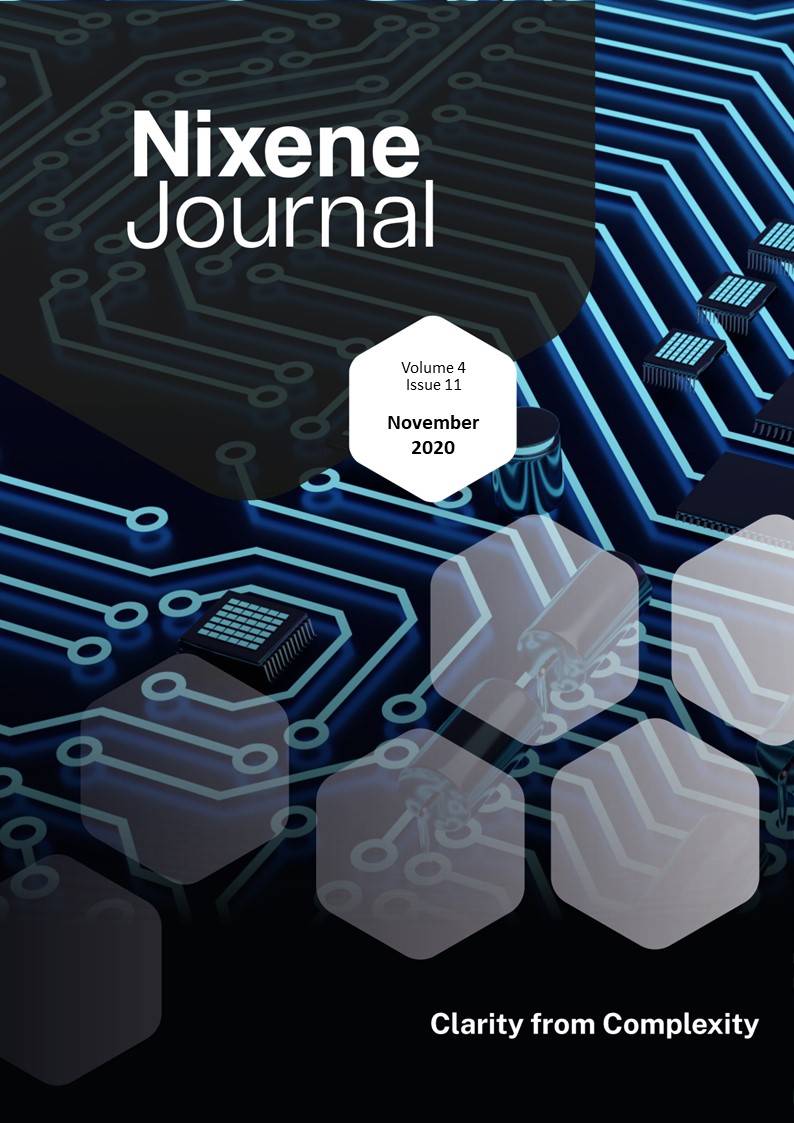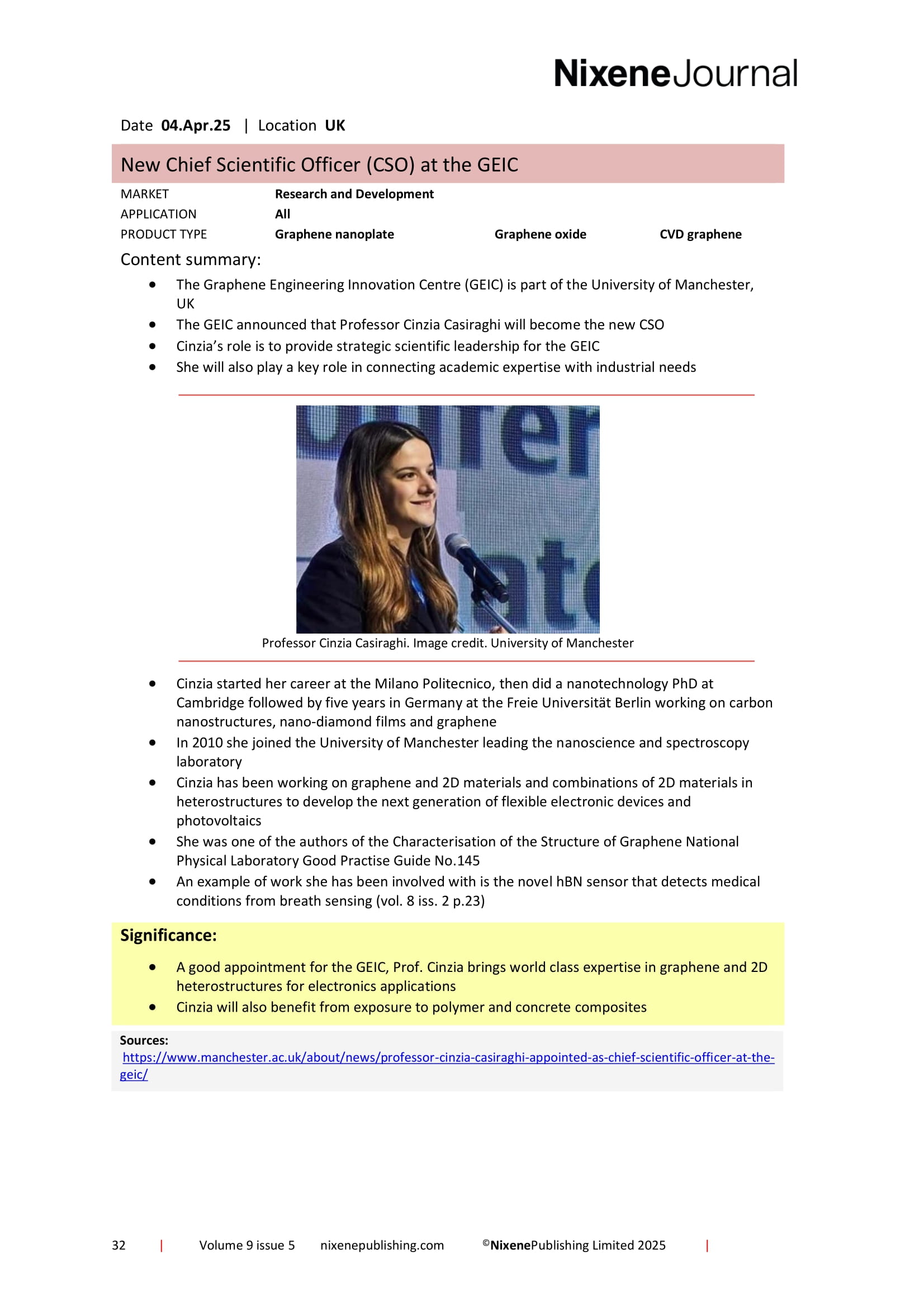Journals
This product is relevant to the following:
Material:
Other:
, ,Locations:
Markets:
Applications:
Product Types:
Technologies:
Related products
-

Vol 6 Issue 5
Over the past five years, we have been paying attention to how graphene can improve battery technology. The market focus has been on batteries for electric vehicles. Graphene has been used in the electrodes, and this has made improvements in charging time and battery life. However, energy density has not been improved. Energy density is the amount of energy that can be squeezed into a given volume or mass. This is important for electric vehicles because the higher the energy density, the further a vehicle can travel for a given quantity of batteries. MIT have been paying attention to this battery development dynamic. A spin out company from the university called PolyJoule has developed a new battery (p. 21). This has even poorer energy density, one fifth that of lithium-ion technology, so this is not going to be used for electric vehicles. The MIT researchers have spotted another market – grid storage. These new batteries appear to be ideal for grid storage applications. They charge and discharge rapidly have a long battery life, do not require cooling, and do not need lithium and toxic heavy metals. These batteries are a new intermediate-type between lithium ion and lead-acid technology. We will pay closer attention to this company in the future because storing electricity from renewables such as wind and solar power requires effective grid storage batteries. Also in this issue, Debbie interviewed the CEO of Ceylon Graphene Technologies. This company has local access to some of the highest quality graphite in the world and is very well equipped to process and develop this into high quality graphene powders (p. 7). The company is actively working on new products and extending the value chain towards the market applications. It will be fascinating to see the results of this activity in the market in the coming years. Yet more fascinating research is being published. You may recall that Debbie met Chris Griggs and Sarah Grace Zetterholm of the US Army ERDC (Vol 5 iss 12, p.10). Their team has developed a graphene filter that removes the toxin produced by algal blooms. This filter cleans up poisoned water that is harmful to humans and fish(p.13) Staying with the biology theme, researchers in the Netherlands have developed a graphene sensor that can listen to the sounds made by individual bacteria. This sensor could find uses exploring the effectiveness of antibiotics with unprecedented precision. Another team in the Netherlands has been developing graphene sensors for testing in space. SpaceX launched these sensors this month. The sensors are now approaching a sun synchronous orbit where their performance will be evaluated. Graphene really is out of this world, and as usual there is so much more to read in this issue. Adrian Nixon, 1st May 2022£45.00 View product -

Vol 4 Issue 11
When I was studying Chemistry, I remember being fascinated by a massive wood and glass cabinet at the college entrance. It was a periodic table containing actual samples of the elements. The lasting impression was how many of the elements were metals. Non-metals are in the minority. There is method in my recollection. A few weeks ago, a new form of carbon was announced by a team in the USA. They call it U-carbon and it is metallic. It conducts electricity, is magnetic and the sample they have made looks just like a highly polished metal mirror. Carbon is not a metal. Or is it? U-carbon is a layered combination of 2D and 3D material. This one will keep scientists arguing about definitions for some time to come. In the meantime, the applications for something that is mirror-like, has a very high melting point, is electrically and thermally conductive as well as magnetic and extremely hard, will be myriad. U-carbon is something to watch. Another research project hit the headlines this month. The University of Arkansas announced they had made a device using graphene that extracts limitless electrical energy from Brownian motion. I spent several days with two of the smartest people I know to figure out what was actually going on here because this work appears to invalidate earlier work by Richard Feynman. We think we’ve got to the bottom of this and while their device works at the small scale, we think they will encounter problems scaling up and discover that Richard was right all along. Time will tell. Yet more fascinating work has been done by the Pacific Northwest National Laboratory. They have made a new material; a graphene-copper metal composite. This is a new shear forming technique for making metal components and wires from powders. This shows 5% improved electrical conductivity compared with copper. General Motors is already working with this to lightweight their electric vehicles. We can see huge opportunities in space and clean energy where lightweighting electrically conductive copper will be a significant leap forward. Chinese electronics hardware company MSI has embraced graphene composites. Their latest graphics card has a casing made from a graphene enhanced polymer that is four times stronger and conducts heat sixteen times better than the normal plastic they used for the casing. Another eye-catching development was made by researchers at the University of Surrey. They have found that adding small amounts of graphene to an acrylate-based polymer makes it look like a green opalescent material. More importantly its colour changes red when squeezed and blue when stretched. This is reversible. It also responds to temperature too, losing its colour irreversibly above a set temperature. This means they have created a sensor that does not need batteries. As usual there is so much more in this issue, the pace of this field is astonishing. Adrian Nixon, 1st November 2020£45.00 View product -

Vol 6 Issue 2
A graphene toaster was demonstrated for the first time at the consumer electronics show in Las Vegas by Korean company Graphene Square. This may not sound like a world changing invention, but it is something worth paying attention to because this is a rare application for chemical vapour deposition (CVD) graphene in a consumer electronics device. Until now, CVD graphene has been used in very small pieces in sensors. This toaster has a piece of CVD graphene on the top and bottom glass panels making a transparent infrared grill. The graphene is made at a scale of 200mm x 150mm and this tells us a that the company has a viable CVD roll to roll process. The process can make graphene at this scale and also provides the capability to separate the graphene from the forming substrate to other surfaces, in this case glass. The next step is to do this commercially. Graphene Square admits this is still at least a year away. This is still impressive progress and tells us that the industrial manufacture of CVD graphene is developing quickly. CVD graphene is also in the news this month. British company Paragraf announced through Queen Mary University, London, that they can create graphene at wafer scale, and this could be a replacement for indium tin oxide (ITO). This was picked up by technology blogs around the world, and graphene manufacturer Versarien felt obliged to disclose it is working on a similar project with a graphene manufacturer in Korea. These announcements about CVD graphene touchscreens sound impressive. However, as far as we can tell from the current state of the art, the economic and technical cases are not sufficiently proven to convince us we will see this technology in the immediate future. The term ‘bottom-up graphene’ used to refer to CVD graphene assembled atom by atom. Graphene powder manufacturing has been evolving rapidly over the last few years and can now be made by atomic assembly methods too. We have summarised the various methods in our special feature. We also look at the implications for competitive activity, as these new manufacturing methods meet the new market dynamics driving the sustainability agenda. While we cannot state which individual companies will achieve success, we can make some predictions about the characteristics successful graphene powder manufacturers will need to have. We hope you agree this makes for fascinating reading along with the rest of the compelling content this issue. Adrian Nixon, 1st February 2022£45.00 View product -

Vol 5 Issue 4
I need to start this month’s issue with a correction. In the last issue (Vol 5 iss 3 p.13) I stated that Kostya was moving from Singapore to Russia. Thanks to our rather well-informed readership, I have been told that Kostya is indeed taking up the position of head of the Brain and Consciousness Research Centre in Moscow, Russia. However, he is not leaving the National University of Singapore. Onward with our usual Accuracy, Brevity and Clarity. Normal ABC service resumes. This month we had a meeting with Prof. James Tour and the GEIC. Thanks Debbie. The work on Flash Graphene (FG) is advancing faster than we realised. Prof. Tour testified to Congress about the benefits graphene can bring to buildings and infrastructure in the USA. He testified to Congress in 2017 and now said “Four years later I’m here to report that the future has arrived” (see page 21). You will know that FG can be made from anything that contains carbon. Waste plastic is a favourite (Vol 4 iss 8 p.9). We learned that Flash Graphene can now also be made from furnace black, the by-product from the leading ‘green’ manufacturing process for Hydrogen (see page 22). The Rice University laboratories and spin out company, Universal Matter, are working on the production of Flash Graphene. The pace is fast. Every nine weeks doubles the scale at which FG can be made. Flash Graphene is something we’ll watch closely. If the team can continue to scale up the process it has the potential to make many other methods for making graphene powders obsolete. We have three special features this month. A review the state of the industry for manufacturing large scale sheet graphene, and interviews with two graphene company business leaders, Maví Figueres and Dylan Banks. Such is the pace of change, while we were writing the special feature, General Graphene sent samples of their monolayer and multilayer graphene to the International Space Elevator Consortium (ISEC). The samples will be sent to the International Space Station (ISS) for testing. We have the first pictures of these large-scale graphene samples in this issue (see page 29) It is worth noting that Graphene has gone from impossible to industrial in just 17 years. Astonishing. Other things to draw your attention to include an emerging controversy with graphene facemasks in Canada (see page 30) and new perovskite 2D materials start to feature in this issue. You’ll discover more as you read on. Adrian Nixon, 1st April 2021£45.00 View product



